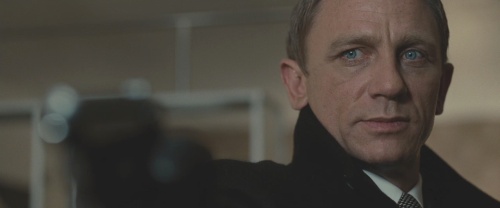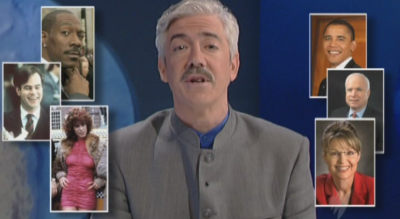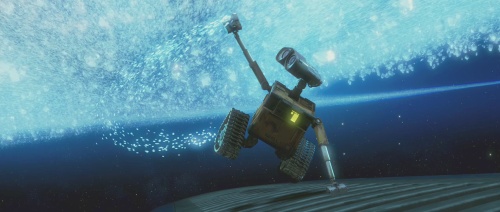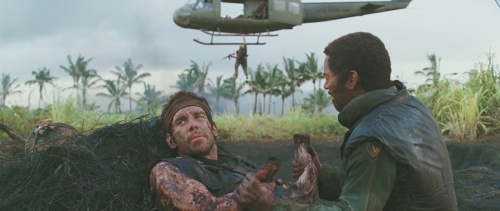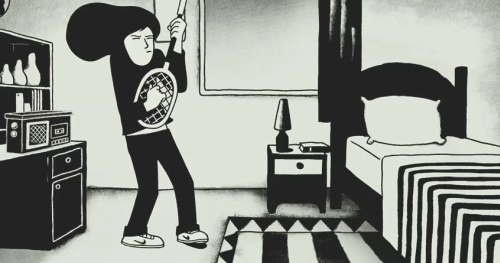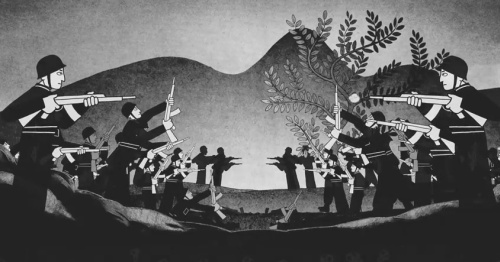This Christmas season, planners everywhere will face the eternal question: what to buy for the planning nerd who has everything? Once that special planner in your life has all the PIA merchandise, their own copy of ShadowDraw, a scale ruler, and SimCity 4 (with Rush Hour expansion pack), what else is there? Well, we’re here to help.
Stephen Rowley
Quantum of Solace (Marc Forster, 2008)
The new Bond film, Quantum of Solace, is a strange beast indeed. It aggressively imitates the rival Jason Bourne spy franchise; and yet despite that derivativeness, it somehow manages to impart a sense of renewal and vigour to the Bond series. In that sense it continues the work started by Casino Royale admirably. And while it doesn’t always feel like a Bond film, it does feels like those at the helm are actually concentrating – something that was missing in plenty of more identifiably “Bondian” entries in the franchise.
It starts mid-chase, in the immediate aftermath of Casino Royale, thus reviving the idea of film-to-film plotting that had been used (albeit more loosely) in the sixties Bond films. Bond is still smarting from the death of Vesper Lynd, and he’s following the leads she left him to try to find the organisation that was backing the previous film’s villain, Le Chiffre. Quantum thus gives a sense both of the film that should have followed the death of Bond’s wife in On Her Majesty’s Secret Service, and also of what the previous “renegade Bond out for revenge” film Licence to Kill should have been. It also very strongly echoes The Bourne Supremacy, right down to the icy Russian epilogue.
I occasionally feel like I should just give up on this site and just re-register this site under the domain name www.pointingoutgreatstuffDavidBordwellwrites.com. As I said at the start of October, other writing and projects have been taking me away from the website. But I can still find time to point out something good that Bordwell has written. This time, it’s his fantastic post looking at the US election campaign, and the attempts by Republicans and Democrats to shape “narratives” around the candidates, from the point of view of one of our foremost theorisers of cinematic narrative. Head on over: it’s a great read.
A far less intellectually rigorous link between the election and films was offered by the inimitable Shaun Micallef on Newstopia:
Watching it all unfold over the last twelve to eighteen months, it struck me how similar it is to the film Trading Places. An elaborate social experiment with Barak Obama in the Eddie Murphy role, elevated to a position of great power and influence in a normally Anglo-Saxon world. John McCain is the Dan Aykroyd character: moneyed, born to rule, and forced to work with a woman he normally wouldn’t be seen dead with. In the end, the combined efforts of Obama / Murphy and McCain / Aykroyd wipe out the share value of all the stocks owned by the people who put them where they are.
Originally published as an editorial under a joint by line with Tim Westcott and Gilda Di Vincenzo in Planning News 34, no. 10 (November 2008): 4.
In last month’s Planning News, Tim Biles made a call for reform from within (“Reflections on Reform School”). Citing the unhappy experience of friends who had been trying to get a simple renovation through Council, he queried whether “the rule book and its policies have become the refuge of the faint hearted,” and made the following call for change:
Is there something simple you could do to make our planning system more effective? To put a smile and not a snarl on the face of the constituents we are meant to serve? Is it possible that this change, the ideas for reform, could well up from the bottom rather than be left to others at the top?
We salute, and heartily endorse, Biles’ call for self-examination in the profession. Yet we would add one major qualifier to his comments. Because Biles writes as one of the state’s most longstanding and respected private consultants, and frames his comments in the context of an account of the difficulties dealing with an unnamed Council, these comments could be seen as a call from one side of the profession to the other to lift their game. That’s an impression we think should be dispelled. There is no point in advocating for introspection if that becomes call for others to take a good look at themselves.
WALL-E (Andrew Stanton, 2008)
Note: this review includes spoilers and my usual rambling ruminations about animation in general.
“There’s something warm and inviting about most animation in just about any classic Disney animated feature, and computers are just never going to pull it off.”
– Thad Komorowski, reviewing WALL-E
Pixar’s WALL-E is a refreshing change of pace. When almost all the productions of their rivals involved a group of animals teaming up and sharing an adventure (a format that even Pixar’s last film, Ratatouille, shared), Pixar have instead gone for a science fiction parable. The result retains their patented sweetness, but gives it a welcome sense of renewal. Pixar’s recent output had been invigorated by the recruitment of the immensely talented Brad Bird, but there was a feeling that Bird’s contribution to The Incredibles and Ratatouille might have been camouflaging a slide in the studio’s work. Certainly Cars, on which Bird did not work, was relatively dull and conventional. WALL-E, however, was written and directed by one of Pixar’s in-house talents, Andrew Stanton (who directed Finding Nemo and co-directed A Bug’s Life), and it shows that there is still a creative spark at Pixar beyond Brad Bird.
 Originally published as an editorial under a joint by-line with Tim Westcott and Gilda Di Vincenzo in Planning News 34, no. 9 (October 2008): 4.
Originally published as an editorial under a joint by-line with Tim Westcott and Gilda Di Vincenzo in Planning News 34, no. 9 (October 2008): 4.
Coming out and calling for the government to spend up big on public transport can seem a little naïve. “More trains! More trams!” Such calls are seen as the business of lobbyists, not professional planners, who must face up to infrastructure costs and political realities. Two contributions to Planning News in the last 12 months, for example, have made valid criticisms of pie-in-the-sky transport advocacy. In the December 2007 issue, Gavin Alford wrote of the difficulties planners face in avoiding simply delivering wish-lists of proposals that are unlikely to be delivered. A related thought was expressed by Peter Jewell in March 2008, when he reminded planners that “public transport is not a panacea,” and questioned how much public transport improvements could realistically be expected to achieve. These comments pinpoint a real difficulty in talking about public transport. Demanding better infrastructure can become a cop-out: unless we’re the Premier or Transport Minister, it’s somebody else’s problem. At the level of day-to-day practice, Alford and Jewell are right to warn us off such an approach.
Tropic Thunder (Ben Stiller, 2008)
Ben Stiller co-wrote, directed, and starred in Tropic Thunder, and the film’s big budget is a sign that studio heads still have confidence in Stiller to deliver a solid, audience-pleasing comedy, despite a somewhat mixed track record in recent years. And for the most part, he does. This is Stiller’s first effort as director since Zoolander, and it’s amongst the better of his recent films.
The concept is that a bunch of actors are making a Vietnam war film: the headline performers are Stiller, as an action hero; Robert Downey Jr as a self-important Australian actor (think Russell Crowe) who has had himself surgically altered to play an African American, and now never breaks character; and Jack Black, as an obnoxious lowbrow comedian. The film is going disastrously over budget, so the director (Steve Coogan) decides to film it “guerrilla style,” with the actors under surveillance in the real jungle. Unfortunately the plans quickly go awry, and the actors find themselves in a real combat situation when they run foul of actual guerillas.
Star Wars: The Clone Wars (Dave Filoni, 2008)
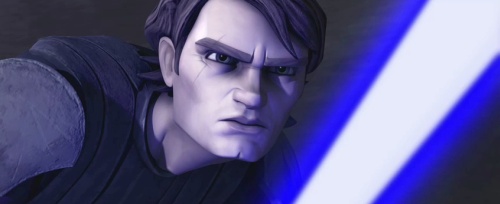
The first thing you need to know is that this is not a proper movie. It’s three episodes of an animated TV show strung together and released in the cinemas.
The second thing you need to know is that this is going to get (and has already received) some terrible reviews. Reading the first reviews from the usual geeky corners of the internet, like Harry Knowles’ rant or Alexandra Du Pont’s similarly disillusioned but much better written dismissal, you see these Star Wars nerds exorcising some demons and finally going to town on a Star Wars film. Even amongst all the hate for the prequels, there was always an undercurrent of indulgence as fans went looking for the good things. A similarly forgiving attitude was taken to the first animated Star Wars series by Genndy Tartakovsky (confusingly, also called Clone Wars, only without a leading “The”), which was generally well received by Star Wars nerds, who appreciated its emphasis on action and adventure. Now, though, by taking what is basically a CG-revamp of Tartakovsky’s take and having the temerity to put it on the big screen, it’s like Lucasfilm has given a green light to expressions of completely unabashed fan hatred. Those who respected Lucas’ past achievements, or Tartakovsky’s qualified success with a difficult format, are not going to feel any allegiance to Dave Filoni’s copy of a copy. In this context, the hate Star Wars: The Clone Wars is going to receive is perfectly understandable.
Persepolis (Marjane Satrapi & Vincent Paronnaud, 2007)
Even those who love animation are prone to dark speculation about its shortcomings as a medium. The lack of live actors and the associated hindrance to truly subtle performances, in particular, is often cited as limiting the potential for serious dramatic work in animated films. The fear is that the relative paucity of full length, adult-oriented dramatic features might not only be due to a lack of courage and imagination on the part of directors and studio executives, but might also reflect actual limitations of animation itself. Thank goodness, then, for Marjane Satrapi’s Persepolis.
The film is an adaptation of Satrapi’s autobiographical graphic novel of the same name, and tells the story of her childhood, adolescence and early adulthood in Iran and Europe, set against the background of Iran’s turbulent politics. It’s difficult material, requiring sensitivity not just to the personal coming-of-age story, but also to the story of Iran through this period. The film is triumphant on both counts. Along the way it demonstrates that the medium of animation not only can overcome its limitations, but actually has some crucial advantages over live action in telling this story.
(Can I pass off my appalling MIFF puns as a tribute to the bad puns of old cartoon titles? No? Oh.)
Well, I’ve finished MIFF with three films back-to-back this afternoon; all good (or at least enjoyable), thankfully. I also saw two on Friday. So I might as well wrap them up briefly while the thoughts are fresh.
Persepolis (Marjana Satrapi, 2007)
I’ll do a fuller review of this in the next week or so (hopefully), so more on this later. But suffice to say it’s brilliant, and you absolutely should see it when it comes out.
Encounters at the End of the World (Werner Herzog, 2007)
I didn’t dislike this to the same extent Mark Lavercombe at Hoopla did, but it was disappointing. Sharing more than a little in common with Herzog’s earlier science-fiction / documentary / head-scratcher The Wild Blue Yonder (which I covered at a previous MIFF, see here), it sees Herzog travel to Antarctica to talk to various research scientists. Herzog is, of course, an eccentric of long standing, and sometimes (most recently in Grizzly Man) his off-kilter perspective can be strangely brilliant. Here, though, he generally comes across as foolish. He has some interesting interview subjects, and certainly gets some great footage in the scenes of diving under ice (it’s here the film resembles Wild Blue Yonder – it may even reuse some of the same footage). But he consistently seems the least intelligent person in the room: his narration ruminates on humanity’s relationship with the environment, but his interview subjects are vastly more informed than he is on the topic. Funny, often beautiful, and Herzog is never a waste of time; but there’s a sense that Herzog is resting on his laurels as one of the great documentarians, rather than really chasing down a great story as he did back in Grizzly Man.
